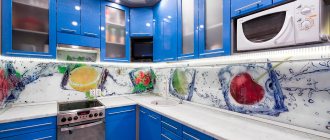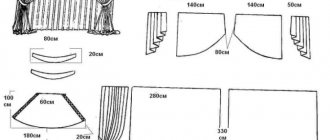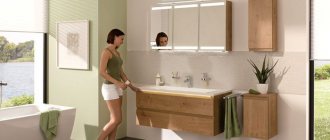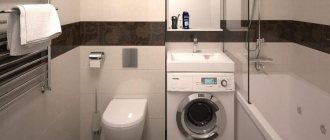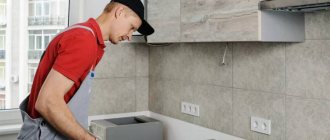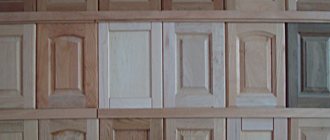Kitchen design
0
4 236
Share
After updating the kitchen unit and the interior as a whole, you need to think about protecting the walls above the work surface. Many people decide to make an apron in the kitchen with their own hands. In order for the expended efforts not to be in vain, you need to choose the right material, design, determine the dimensions and carry out the installation correctly.
Your kitchen will become stylish and unusual with an original apron
- Choosing an apron option
- Features of arranging an apron made of various materials
- Ceramic tile
- Mosaic
- Beautiful stone
- Laminated MDF panels
- Glass
- Metal
- Sizing
- How to properly install and make an apron with your own hands: laying and installing tiles, gluing discs
What material or fabric is better to sew from, sew a home apron, apron: tips
An apron is exactly that “mandatory” thing that every housewife should have. You can purchase it at any store or sew it yourself (this will testify not only to your skill, but can also be the most practical thing, since it will be made taking into account all your features).
It is customary to keep several aprons in the house, for example, for each family member or in the case when one apron gets dirty and another is needed “for backup.” An apron (or “apron”) is needed not only for working in the kitchen, but also in cases where you care for flowers in the garden, “digging” through old things, doing cleaning, or even repairing a car.
There are many styles of women's and men's aprons that perfectly protect clean clothes from dirt, dust, and wear. The apron can be attached to the waist or neck, covering the chest. If you have enough aprons, you can sew one to give as a gift to a loved one.
INTERESTING: You can not only feel comfortable in an apron, but also work comfortably, because it is equipped with many large and small pockets for storing handy things.
When creating an apron, remember that it should not only be good and comfortable, but also beautiful. For a self-made apron to turn out very “successful”, you should choose its style in advance, find patterns and purchase practical material.
The material for sewing an apron should be one that can “accept” all types of dirt and not stain the material of clean clothes. In addition, the apron gets dirty too quickly and very often, and then it is important that the material can withstand frequent washing well.
Which materials are best:
- Teflon fabric (capable of passing water, but not absorbing stains; the only drawback of this material is that it is relatively expensive).
- Linen (absorbs and allows moisture to pass through well, and can be easily washed many times).
- Cotton (light fabric that is practically not felt on the body, absorbs moisture well and washes well, withstands high water temperatures).
- Denim (a very unusual material, quite dense, but heavy and its weight is immediately felt on the body).
Other tips:
- It is best to choose colored fabric for an apron. On such a material, stains will not be as noticeable as on a plain and light material.
- Another option is to sew an apron from a dark fabric, for example, blue, black, purple.
- You can diversify such aprons with different colored inserts.
Different types of aprons, sewn by yourself: styles, styles, cuts
A creative approach to sewing an apron for the home with your own hands
Home apron made from an old men's shirt
Beautiful aprons for home and kitchen made from bright materials
Home apron in loft style made of denim or linen
Home aprons made from combined materials
A creative approach to creating an apron with your own hands (an apron with a fluffy petticoat)
What other materials can be used?
That's it for the basic ideas on how to decorate the apron. Next there will be only very original options.
Laminate or parquet
Laminate is preferable for use on an apron, and even more often it is cheaper than parquet. It is worth choosing high-class material (32-33) and good locks with moisture protection. You will have to install it yourself, since they do not sell ready-made laminate panels for aprons. Attached with liquid nails.
A parquet apron is made differently: first, the “dies” are attached to the substrate with glue or liquid nails, then everything is varnished and also attached to the wall. But the varnish on a stove can melt or crack, so this method is not suitable for everyone. You can cover the parquet with glass, but then the apron will turn out to be too thick - this will not suit everyone. But it looks very original.
Brick
Natural or gypsum brick is absolutely not suitable for an apron because of its porous structure: all liquid and dirt will be absorbed inside like a sponge, and cleaning it later will be very problematic.
Glass will come to the rescue again and protect this interesting design solution. But this way the texture of the brick will be lost, so it is better to simply move such a decorative element away from the food preparation area.
Wine corks
Yes, they do this too - they line the apron with wine corks. Moreover, they not only collect them themselves, but also buy them (!) from bars and restaurants. To make the process go faster, cut them into halves - this makes it easier to glue them to the substrate.
The laying pattern is the same as for parquet. Only the material of the plugs is porous, so cleaning them will be a big problem. You can resort to a constant assistant - glass, but is it worth increasing the already thick apron? The idea with wine corks is suitable for a dining place, but for a work area in the kitchen.
Discs and glassware fragments
Here all the necessary and unnecessary garbage comes into play: broken dishes, whole dishes, CDs - all this is glued to the substrate, and the joints are covered with tile grout. It looks impressive, because it is simply impossible to find a second apron like this.
But here the problem with the seams comes up again, which will have to be cleaned often. In addition, CDs have a mirror surface, on which all drops and dust particles will be visible.
Pebbles
If you are a fan of pebble beaches, then you can create such a corner in the kitchen. For example, in the form of an apron. But since the surface of the stone is not uniform, it will be very difficult to clean it, dust will get between the stones, and as a result, such a panel will quickly lose its original appearance.
Chalkboard paint
A very original method is to make a slate board instead of an apron. All that is required is to go over the required space with slate paint three times. It is easy to care for: avoid abrasive detergents and hard sponges.
With the help of drawings on the board, you can change the look of the kitchen every day - you definitely won’t get tired of it. It will look especially impressive in a white kitchen.
How to make a pattern for an apron, apron 46, 48, large size?
In fact, an apron is a dimensionless accessory, as it has no fasteners or buttons. In cases where the apron “turns out to be small,” it should only be tied looser at the waist or the ribbon that holds the bib behind the neck should be lengthened.
How to make a pattern and sew an apron:
- In order to sew an apron correctly and accurately, you will need paper, fabric, scissors and thread (or a sewing machine).
- First, draw a pattern on paper (it consists of two large squares, three ribbons and two pockets).
- You can cut the pattern from paper such as whatman paper, wallpaper or a sheet of newspaper (large spread).
- After this, the pattern is applied to the fabric and the apron blank is cut out.
- Each edge is folded and stitched, after which pockets and ribbons are sewn on (on the neck and on both sides for tying at the back).
- The decorative finishing of each apron is done to your liking.
Pattern:
Pattern for a simple apron (any size)
Functionality of a kitchen apron
A kitchen apron is the part of the wall between the work table and the wall cabinets.
When performing kitchen work, this area is more exposed to various factors than others:
- splashes of water from the sink;
- drops of fat, oil, boiling water from cooking;
- juice and pieces of fruits, vegetables, meat, fish when using a knife, blender or mixer;
- high temperatures at the installation site of stoves and ovens;
- hot steam
Under such influences, wallpaper or paint quickly lose their neat appearance, become deformed and even separate from the wall. A kitchen apron made from denser and harder materials will help you avoid such troubles.
This kitchen detail serves not only as a protective element, but also as an aesthetic one. A carefully thought-out design of the product will turn it into a significant element of the interior.
How to properly sew the details of an apron?
Adviсe:
- It is best to sew the apron parts together using double stitching to ensure the product is durable.
- The apron skirt can be folded into a small fold and stitched so that it is fluffy and voluminous. This will add elegance to the product.
- The tape that holds the bib should be exactly the length that suits you, so take measurements in advance.
- The length of the belt on both sides is not so important, so you can make it with a margin. It is better to cut off a belt that is too long or tie it twice around the waist.
How to do it yourself?
It is advisable to entrust the finishing of walls in the work area from MDF or glass to professionals. Other options for materials are easier to lay out yourself. Before installing the selected products, you need to determine the requirements for aprons.
Preparation of base surfaces and premises
It is recommended to install plastic panels, glass or MDF after fixing the kitchen set to the enclosing structures. It is necessary to take accurate measurements, which will allow the apron to fit into the existing space.
If tiles, boar mosaics, natural or artificial stone, as well as porcelain stoneware are used to decorate the work area, “wet processes” associated with the use of mortar are required. To prevent the building mixture from getting on furniture elements, we move all cabinets away from the walls. At the same time, it is important to know in advance where the kitchen set will ultimately be located. At the same time, the distance from the countertop to the bottom of the wall cabinets is measured.
Let's get acquainted with the requirements that apply to the room when installing an apron:
- It is mandatory to have installed windows in the kitchen.
- Electrical wiring has been installed and socket boxes have been secured.
- The presence of leveled plastered walls. The use of putty on gypsum binders to level the surface is not allowed.
- Horizontal flat floor with finishing coating.
- The room temperature is within +5/+30 degrees, air humidity is about 60%.
Important ! The wall for installing the apron must be perfectly leveled and dry. When using glass to decorate a work area, it is recommended to use polymer cement solutions to level the base.
Marking work
We apply markings on the base surface ready for cladding.
Before carrying out such work, you need to know about the location of the furniture in the room, so the kitchen set must be purchased and installed before installing the apron. Step-by-step instructions for applying markings are as follows:
- We calculate the space between the bottom of the cabinets and the countertop, adding another 2 centimeters in each direction to the base size. The standard distance is 60 centimeters. Depending on the height of the owners, this parameter can range from 45 to 70 centimeters.
- The height of the countertop also depends on the height of the residents who use it and the dimensions of the built-in appliances. The standard height is 90 centimeters.
- The hood and wooden kitchen set are placed above the countertop at a height of 65 centimeters when using an electric hob, or 75 centimeters for gas cookers.
- The apron is not always located between the cabinets and the countertop; it can be made with a slight overlap on the side surfaces. This is especially true for cases where the sink and stove are located at the edges.
To mark the work area, use a regular construction or laser level. The work is carried out in the following sequence:
- make marks on the wall at the location of the bottom of the cabinets and the top plane of the countertop;
- transfer the mark to another section of the wall using a laser level;
- we beat off the line using a painting cord;
- On parallel lines we mark the position of the hood, side cabinets and hob.
The apron should extend beyond the tabletop and furniture by at least 2 centimeters. We set this distance aside from the main lines and make a beating with a cord. During marking work, it is necessary to take into account the overall dimensions of the tiles along with the seams, which will prevent cutting of the products.
Area calculation
After calculating the amount of material required and drawing marking lines, it is necessary to calculate the area of the apron. To do this, just multiply the length by the width of the square. All distances must be converted to meters.
We sew aprons, simple aprons for the kitchen: ideas, styles and patterns
You can choose exactly “your” version of a home apron by studying all possible ideas and patterns. Choose exactly the style that you think will be beautiful and practical. The fabric for the apron can be taken from old scraps, remnants of clothing, or you can buy special material.
Apron patterns:
Patterns of different types of aprons No. 1
Patterns of different types of aprons No. 2
Patterns of different types of aprons No. 3
Patterns of different types of aprons No. 4
Patterns of different types of aprons No. 5
Patterns of different types of aprons No. 6
Patterns of different types of aprons No. 7
Patterns of aprons of different types No. 8
Types of MDF panel coatings
An MDF kitchen apron differs in the types of panel coatings.
Decoration of materials is carried out using different technologies:
- lamination;
- veneering;
- toning;
- laminating.
Laminated panels are made using coatings with melamine paper or polyvinyl chloride film. The coating is impregnated with resins and serves to prevent mechanical deformation, making the material resistant to high humidity and treatment with chemical compounds. Laminated boards are used to create aprons of simple shapes and custom design solutions (curved, semi-circular).
Laminated boards differ in the shape of the end cuts, therefore they are used in structures with different radii. The material is resistant to changes in temperature conditions and is used for finishing the façade part of the set. The thickness of the slabs is 16-22 mm, the bending strength reaches 23 MPa, and the density is up to 50 kg/m3.
When processing surfaces on special machines, an imitation of natural wood, marble and granite surfaces, sandstone, leather, brickwork, metal, etc. is created. Laminated products can be supplemented with methods of artificial aging and matting.
Painted MDF boards are distinguished by high moisture-resistant characteristics, are decorative, and are available in a wide range of shades and textures. A special coloring composition is applied to standard coatings with a spray. The surface can be matte, glossy or pearlescent. A 3D drawing can be applied to the coating.
Technologies make it possible to give slabs a vintage, retro, etc. look. Complex color combinations are created by applying several layers of dye. The panels are painted to match the types of wood (oak, alder, ash, walnut, mahogany, etc.). Toning is performed in non-standard colors for modern styles (pink, light green, blue, purple, etc.). The coating can be monochromatic or with a combination of different shades and textures.
Veneered panels are used to decorate kitchens with a wood look in rooms in country, rustic, Provence, and Scandinavian styles. The slab manufacturing technology involves lining materials with a thin cut of wood (veneer) through hot pressing. Adhesive resins are also used in the work.
Manufacturers offer veneered boards of standard sizes or custom-made ones - with cutting for a design project. The edges can be processed with a special edge. The materials differ in density and edge thickness. The price is higher for slabs veneered with expensive wood species. They are used on the front part of the kitchen unit.
MDF panels processed by lamination are covered with plastic using a special base. The materials have high resistance to humidity, high temperature, durability, and practicality.
Laminated MDF is distinguished by high noise and heat insulation parameters, a variety of textures and shades (allows for the implementation of original design projects). The shade lasts for a long time, the color does not lose intensity from sunlight. The material is easy to clean; dirt can be removed with a damp cloth. Its advantage lies in the environmental friendliness of the components; the processed slabs are similar to natural wood.
We sew aprons, aprons for the kitchen ourselves with frills, ruffles: ideas, styles and patterns
Aprons made with frills, decorated with embroidery, lace, inserts from other materials, pockets and complemented by an unusual cut always look much more interesting and pleasant than a classic apron.
IMPORTANT: You can get ideas for sewing and get acquainted with patterns of “interesting” aprons in this article.
Options:
Photos and patterns of modern aprons No. 1
Patterns and models of aprons No. 2
Patterns and models of aprons No. 3
Unusual ideas
If the classic options are not suitable, make your own kitchen apron from scrap materials.
The simplest and most budget option is PVC (polyvinyl chloride) oilcloth, which is usually used to protect kitchen tables.
Cut out a piece of oilcloth of suitable size and attach it to the wall (previously marked) with a furniture stapler.
You can staple the oilcloth onto a piece of plywood, which is glued to the wall using “liquid nails” or any universal glue. In such an apron it is easy to make holes for sockets.
An oilcloth apron can last up to three years.
If you have a large number of unnecessary CDs accumulated at home, you can also use them.
The discs are cut or broken into pieces of different sizes and shapes. Glue to the wall with universal glue. The seams are treated using a rubber spatula with grout for ceramic tiles, and the excess is washed off. You can cover the top of the apron with transparent plastic or glass.
An interesting result is obtained from wine corks. They are cut in half or used whole. You can also lay them in different ways: in vertical rows, horizontal, in a checkerboard pattern, diagonally. You can glue them sideways to each other, getting a pattern of round elements. Used for attaching to the wall “liquid nails”.
Cork is porous and soft, so for additional strengthening it is coated with wax or covered with an apron of tempered glass.
By using this glass you can create a unique apron from any materials:
- photographs, drawings, wallpaper;
- recipes;
- newspaper and magazine clippings;
- dried flowers and leaves;
- cuttings of trees, branches;
- shells;
- fabrics.
The parts are fixed to the wall with glue and covered with a piece of glass. When such decor gets tired or loses its appearance, it is easy to replace. The glass is made to order according to individual sizes and fixed with special fasteners.
An apron made from wooden lining will be environmentally friendly and textured. It is easy to install and parts can be replaced if necessary. Cover the lining with waterproof enamel or varnish.
You can also paint a wall or piece of plywood with chalkboard paint. You can leave inscriptions and drawings with chalk on such a board or walls.
We sew aprons, aprons for the kitchen ourselves with bibs: ideas, styles and patterns
The advantages of such an apron:
- Fits well on the body
- You can sew additional pockets on the chest for storing things.
- Covers most of the body, preventing clean clothes from getting dirty.
IMPORTANT: You can find options for beautiful, simple and unusual aprons with bibs in the photographs and sketches below.
Options:
Patterns and models of aprons No. 1
Photos and patterns of modern aprons No. 2
Photos and patterns of modern aprons No. 3
Photos and patterns of modern aprons No. 4
Advantages and disadvantages of an MDF apron
Advantages of an MDF kitchen apron:
- high strength and density of slabs;
- moisture resistance;
- resistance to changes in temperature conditions;
- preservation of shape, absence of deformation;
- ease of installation;
- light weight of particle boards;
- ease of cutting and trimming;
- durability (slabs can maintain an aesthetic appearance for up to 15-20 years);
- the possibility of additional decoration using photo printing, decoupage, coloring;
- environmental friendliness of the composition - no components that are harmful to health are used in the production of pressed slabs; no toxic substances are released during MDF operation;
- easy cleaning of dirt from the surface, MDF boards are resistant to the absorption of dirt and odors, cleaning requires only wet cleaning with a napkin or sponge;
- the use of chemical alkaline detergent compositions is allowed;
- a wide range of shades and textures of panels;
- low price;
- the possibility of laying communication networks, insulation and sound insulation under the slabs;
- easy dismantling of panels;
- maintainability of coatings, possibility of replacing structural elements;
- the material is easy to process, the structure of the wood panel allows processing using a milling machine.
The list of disadvantages of the building material:
- fire hazard;
- fire toxicity;
- with constant humidity, the panels may move away from the wall;
- instability to fats and hot humid fumes.
We sew stylish, beautiful aprons for the kitchen: ideas, styles
The more interesting the apron is, the more attention it deserves, the more pleasant it is to wear, the more such handmade work is worth. Check out the ideas and styles of unusual, very stylish kitchen aprons.
Photo:
Fashionable, unusual and modern aprons for the kitchen No. 1
Fashionable, unusual and modern aprons for the kitchen No. 2
Fashionable, unusual and modern aprons for the kitchen No. 3
Fashionable, unusual and modern aprons for the kitchen No. 4
Fashionable, unusual and modern aprons for the kitchen No. 5
Fashionable, unusual and modern aprons for the kitchen No. 6
For what?
The wall behind the stove has been lined with durable, dense and easy-to-clean materials for a long time. The reason is clear: this is the most dirty spot in the kitchen. You shouldn’t rely on paneling, plastering and painting: everyone knows that grease and soot eat into ordinary finishing, and it’s expensive to cover all the walls with expensive, durable materials. A kitchen apron takes up a small area and is relatively inexpensive. If necessary, it can be replaced without undertaking a general repair. But at the same time, some features appear in its implementation compared to continuous finishing, because The apron actually hangs on the wall. But more on this later.
The second reason has appeared in our days along with new materials. For aprons, in particular, tempered carbonate glass. A wide variety of designs can be applied to it to suit the overall design of the room, see fig. In addition, the glass apron is a solid, very hard plane that is absolutely resistant to grease, is easy to clean and lasts for decades.
Glass kitchen splashbacks
In a kitchen with a glass apron, the lighting from the bottom of the hanging cabinet is especially aesthetically impressive. Carbonate glass has a high refractive index, which gives a beautiful play of light. But, of course, it is not forbidden to highlight any other apron.
The best models and styles of kitchen aprons, aprons for the kitchen with your own hands: photos
Each needlewoman has her own view of things, creativity and work, and therefore there are many original aprons, hand-sewn using unusual patterns.
Photo:
Beautiful and original aprons No. 1
Beautiful and original aprons No. 2
Beautiful and original aprons No. 3
Beautiful and original aprons No. 4
Beautiful and original aprons No. 5
How to properly install and make an apron with your own hands: laying and installing tiles, gluing discs
The type of material used directly determines how the kitchen apron will be attached to the wall. In order to glue the glass, liquid nails are used or the panel is fixed with special fasteners. Tile materials are laid on the solution. You can glue decorative stone with cement-based or polymer-based glue. The mixtures are sold in the form of powder or ready-made plastic mass.
Kitchen with an apron: unusual, bright and original
Let's look at how to make a tiled apron for the kitchen with your own hands:
- The wall surface is leveled and primed. If tiles are laid on chipboard, use a deep penetration primer.
- The surface is marked with allowances for gaps.
- The adhesive is applied with a notched trowel to the wall or the tile itself.
- The element is applied to the control mark, pressed and leveled.
- A gap is established between adjacent tiles using plastic crosses.
- After drying, the seams need to be rubbed. Ideally, epoxy mastic is used. Joints with furniture are treated with sealant.
WATCH THE VIDEO
Correctly selected material and competent installation are the key to a successfully completed job. A homemade apron will serve you for many years and will delight you with its appearance.
Choosing fabric for sewing an apron
Before you start sewing the product, you need to decide on the fabric. Among the many characteristics of textiles, material types are the most important. It depends on them how practical, convenient and durable the product will be. There are 3 main types of fabric used for manufacturing:
- Blended fabrics that combine synthetic and natural fibers. Aprons made from such materials are durable. The downside is that they quickly lose their original color and fade during washing.
Mixed fabrics
- Natural fabrics such as silk, cotton, wool, linen - products have an excellent appearance and high wear resistance. They wrinkle easily and take a long time to dry.
- Synthetic materials are hypoallergenic, inexpensive and durable. The materials become electrified and do not allow air to pass through well. As a result, a person often becomes hot in a product made of synthetic fabric.
You might be interested in: The reasons for missing stitches when sewing with a sewing machine and how to repair them
Synthetic materials
Aprons for chefs in cafes or restaurants are a separate case. This element of the uniform must be comfortable and safe and meet established requirements. Therefore, aprons for chefs are made from high-quality calico with a mixture of polyester. Main characteristics of this material:
- resistance to wear and washing powders;
- environmental cleanliness;
- low cost;
- high density, strength;
- ease of care and ironing.
The most suitable fabric for cutting a professional apron contains 30% cotton threads, 70% polyester. This option is more expensive than calico, but it also has more advantages. The optimal combination ensures resistance to deformation and hygiene. A prerequisite is a special impregnation that protects against the effects of hot steam, fat, and boiling water.
Professional chef apron
Home wear items are not subject to such strict requirements as professional uniforms. And what fabric to choose for an apron, a woman can decide for herself, guided by her own preferences.
Here are the most popular modern options that are well suited for creating a home apron:
- “Diagonal” – cotton fabric with a small addition of synthetics. Special weaving of threads gives an interesting texture with a rough surface. It has elasticity and high density. Pros: thermoregulation, strength, resistance to deformation, pleasant to the touch.
Diagonal
- Linen is an impractical fabric because it absorbs dirt well, can shrink after washing, and requires careful ironing. It has more decorative value - it is difficult to compete with it in terms of aesthetics. It perfectly complements the interior in the Provence, Modern, and Country styles. An apron made of this material is suitable as a decoration for a hospitable hostess during a holiday or as a gift. The stores offer a wide range of fabric colors with and without prints, at an affordable price.
Linen
- Synthetic is a fabric that is inexpensive, easy to wash, and dries quickly. A housewife may have several items made from this material in her arsenal for every day. It is only important to choose high-quality synthetics that will not fade or pill after the first wash.
- Teflon-coated material is viscose, cotton, calico or synthetics, the surface of which is coated with a polymer layer. As a result of processing, the material is waterproof, does not absorb dirt, and reflects heat. An item made from such material can be safely machine washed on any mode. The downside is that it is sold only in specialized fabric stores, and the cost is relatively high.
Teflon coated material
Please note! When choosing brightly colored fabric, you must ensure that it does not stain clothes and skin under the influence of high temperatures.
Quite often, needlewomen use old clothes to sew products - denim, leather goods, bathrobes. Thus, you can spend your time interestingly and usefully, save money and create an exclusive item.

